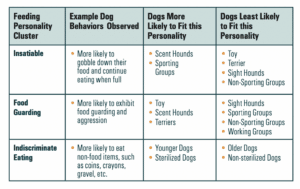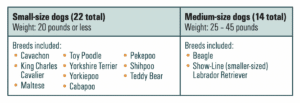OVERVIEW As pet owners increasingly seek tailored nutrition for their animals, understanding how life stages influence eating behavior becomes crucial. This work explores the link between two key palatability metrics, first choice and intake ratio, where in AFB palatability results it becomes clear that flavor preferences in pets evolve throughout...

Are Small Dogs Inherently Finicky Eaters?
OVERVIEW:
What common feeding personalities might dogs share? What implications might they have for pet food manufacturers?
AFB International (AFB) recently partnered with behavioral geneticists at Stonehill College to answer these questions and learn more about dog feeding styles and their influence on dog food consumption and perceived enjoyment. A dog feeding behavior survey of more than 2,400 dog owners from around the world determined three clusters of dog feeding personalities and found that breed groups differed in their food personalities.
One main observation from the survey was that small dogs, including toy and terrier breeds as defined by the American Kennel Club (AKC), were perceived to be more “finicky eaters” by their owners. To assess if dog owners’ perceptions could be validated with objective assessments, AFB studied two dog panels, small breed and medium breed, at their Palatability Assessment Resource Center (PARC). In this controlled environment the research found distinct feeding differences between the two panels.
Small dogs were found to be less focused on their food; easily distracted. This lower focus could be perceived as lesser food enjoyment or being more finicky by dog owners. The research also found that small dogs may be more sensitive to palatability differences than medium-size dogs. When designing small dog foods, these findings demonstrate the need for more focus on palatability, as well as assessing palatability performance with small dog panels.
GLOBAL FEEDING BEHAVIOR SURVEY OF PET OWNERS:
The online global survey of dog owners was led by Dr. Bronwyn H. Bleakley, animal behaviorial geneticist at Stonehill College, and asked questions about their dogs’ feeding behavior and personality. Responses were collected from 50 U.S. States and 30 different countries, representing dog owners of 1,138 purebred and 1,272 mixed breed dogs (2,410 total).
The ages of the dogs ranged from puppy to over 18-years old. All 140 AKC-recognized breed groups were included, and all survey responses were put through standard principal component analysis to look for patterns and uncover similar responses among questions.
FINDINGS FROM GLOBAL FEEDING BEHAVIOR SURVEY OF PET OWNERS:
From the results, three clusters of dog traits were identified –

SMALL- AND MEDIUM-SIZE DOG PANEL TRIALS:
To validate the dog owners’ survey findings, the ‘Insatiable’ personality trait was further studied at AFB’s PARC utilizing the following dog panels:

All dogs were given six different commercial dog foods (5 chicken and 1 beef) and two AFB-developed foods. All dog foods were targeted for their breed size and represented a variety of price points.
NOSE IN BOWLSM was used to analyze and quantify food focus, which equates to the time spent sniffing or chewing food in the first five minutes of mealtime.
RESULTS FROM DOG PANEL TRIALS:
Typical feeding styles of small dogs were significantly different than those of medium-size dogs (p<.001). Small dogs were
less focused on their food, having lower NOSE IN BOWLSM time and 85.5 percent average food focus. They were more easily distracted during eating, with a tendency to look up and around.
Medium-size dogs were more likely to gobble down their food, had higher NOSE IN BOWLSM time and an average 93.1 percent food focus.
The small dogs showed greater differences compared to the medium dogs in their reactions to the foods presented in these monadic NOSE IN BOWLSM trials.
CONCLUSIONS:
For pet food manufacturers, there are two primary implications from the research when designing small dog pet food. (1) Given small dogs lower food focus, pet food manufacturers have an opportunity to keep dogs’ attention on their food longer and overcome their distraction tendency through an increased focus on palatability. (2) Assessment of small dog foods with small dog panels will increase the potential for palatability results translating to perceptions of meal enjoyment in small dog homes.
Additionally, assessment of small dog foods with small dog panels will increase the potential for creating higher NOSE IN BOWLSM time with small dogs, which will also help to increase small dog owners’ perceptions of meal enjoyment.
AFB’s PARC small dog panel is available to support customers with their small dog food trials. To learn more about AFB’s dog feeding personality research or PARC small dog panel, contact your sales representative or visit https://www.afbinternational.com/contact/